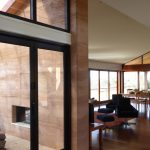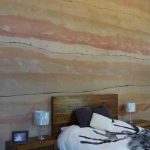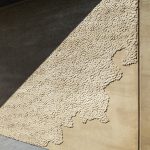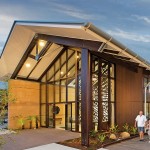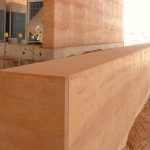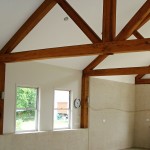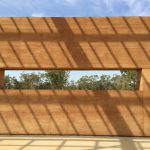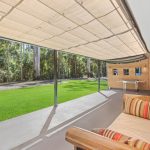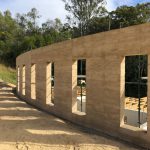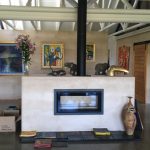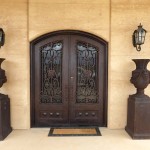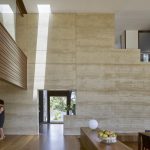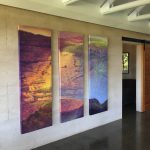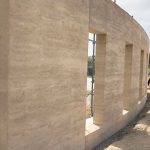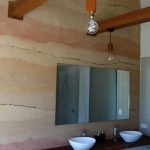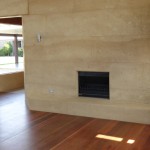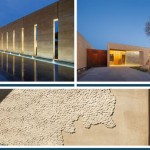Stabilised Rammed Earth
Rammed earth is a method of building walls in situ whereby a selected mixture of earth, sand and aggregate is compacted in layers between forms. Each layer is approximately 15 cm (6 in) deep. As each form is filled, another form is placed above it, and the process begins again. This is continued until the desired wall height is achieved. A wider range of soils are suitable when a small amount (approx 6%) of cement is added to the mix. The result, known as ‘stabilised rammed earth’, is an extremely durable and attractive masonry product with numerous benefits.
Benefits Of Building In Rammed Earth
The many advantages of building with rammed earth include superior thermal mass, temperature and noise control, strength and durability, low maintenance, fire proofing, load bearing and pest deterrence, as well as its beauty and the pleasure of building with a natural and environmentally sound material.
Fire Protection
Earth doesn’t burn. This is an ideal material for bush settings and leafy suburbs. CSIRO tests (as outlined in Bulletin 5: Earth-Wall Construction, Fourth Edition) showed that a 250mm earth block wall achieved a 4 hour fire resistance rating. A 150mm earth block wall achieved a rating of 3 hrs 41 minutes. Our walls are stronger, being 300mm thick and of monolithic rather than block construction, so they have no vulnerable mortar joints.
Thermal Mass
The external walls of our rammed earth buildings are a minimum of 300mm (1 ft) thick, providing excellent protection from extremes in climate. The thickness and density of the material means that heat (or cold) penetration of the wall is very slow and the internal temperature of the building remains comparatively stable, with the end result of it feeling warmer in winter and cooler in summer than the outside temperature. Rammed earth has long been a popular choice for buildings where temperature fluctuations need to be kept to a minimum, such as the wineries of Western Australia.
Noise Reduction
The thickness and density of the walls mean that noise transmission is very much reduced. This is particularly useful if you want to keep out the noise of traffic or in party walls between townhouses. The muting of external noise provides a quieter, more sheltered ambience, particularly evident in bad weather. Rammed earth internal walls are also extremely useful in providing sound insulation between areas with different needs — for instance between living and sleeping areas, or between a public or family room and a study area. CSIRO tests quoted in Bulletin 5 Earth-Wall Construction indicate a sound transmission rating of more than 50 decibels for a rammed earth wall of 250mm. Thicker walls, such as our standard load bearing walls of 300mm, provide even better sound insulation.
Strong and Durable
Rammed earth is extremely durable and weather resistant. CSIRO tests detailed in Bulletin 5 indicated that an earth wall built to their standards should have “an unlimited life as it would be immune to the destructive action of fire, termites and the weather.” We have over 30 years of hands-on experience working with rammed earth. Tested in accredited scientific laboratories for erosion and strength, our mixes have outstanding results. Used with modern technologies and a strong attention to quality control, these mixes ensure maximum strength and durability for every project.
Low Maintenance
Rammed earth walls are extremely low maintenance. Once they are built and sealed, they shouldn’t need any further attention for 10-20 years. At that point exposed walls may benefit from a second coat of sealer, which is an easy process. During the building process we incorporate a water repellent additive especially formulated for rammed earth, and at the end of the process we apply a water repellent to the external face of the walls. Both these repellents serve as additional protection to the already very water resistant nature of the highly compressed earth.
Rammed earth walls are features that stand alone and don’t need further finishing with plasterboard or render, inside or outside. However, if you do want a different finish, rammed earth walls can be treated in the same way as other masonry walls. You can cover them by applying plaster or render, or paint directly onto the surface.
Load Bearing
Rammed earth walls at 300mm thick are load bearing, so you are unlikely to need other structural framing for your home, reducing fire and pest susceptibility. Rammed earth also provides substantial bracing to buildings — usually well in excess of the legal requirements achieved by most timber framed homes.
Versatile
Architects are using rammed earth in commercial and domestic buildings of many styles and for many functions. Variations in texture, colour and finish are possible, and elements such as artwork, reliefs, patterns, circular windows, alcoves and feature stones can be incorporated. In the award-winning Garangula Art Gallery we incorporated a commissioned artwork into the gallery’s entry wall. We have created multi-coloured decorative feature walls for some clients. It is a natural product which blends beautifully with the environment and other natural building materials, as well as with lightweight man-made materials such as Colorbond — a combination used in several award-winning homes. It ‘grounds’ lightweight buildings, providing a feeling of structural solidity and security.
Pest Proof
Termites and other pests can’t eat rammed earth. There are no cavities in rammed earth walls for pests to live in, or to use as a route to the roof or other timbers. As the walls are load bearing it reduces the amount of termite-tempting structural timber. (NB: The Building Code of Australia does not yet deem rammed earth a sufficient termite barrier, so you do need to install termite proofing as usual. Building the walls on a cement slab is the easiest way to do this.)
Healthy and Environmentally Friendly
Rammed earth is non-toxic, non-polluting and ‘breathes’. This creates safer, more people-friendly buildings. It is very low in embodied energy, and extremely comfortable to live in.
Frequently Asked Questions
Can I see some work?
We don’t have a display house as such. Our office is housed in a rammed earth building, so our clients see and feel the rammed earth when visiting us to discuss their plans. We are happy to talk to people in the early stages of development and planning, but you do need to make an appointment in advance – please! Depending on scheduling and accessibility, we may be able to take you to a building under construction. While many of our customers have indicated their willingness to show new clients their finished homes, we prefer not to trespass on this generosity, and will only do so if there is a special feature of specific relevance which cannot be shown elsewhere. While much of our previous work can’t be seen readily from the roadside, there are some where you can drive by and see our work without disturbing the occupants.
How does it cope with rain/storms?
Rammed earth buildings are simply wonderful to be in during storms – unlike lighter-framed homes the walls don’t move or creak in strong winds, and the sounds of thunder, wind and rain are muted. A rammed earth building feels as strong as rock.
Rammed earth is extremely durable. There are numerous examples of rammed earth buildings and structures which are hundreds of years old — for example, much of the Great Wall of China is made using an earlier method of un-stabilized rammed earth construction. Modern methods have improved the finished product enormously from those days. Today’s rammed earth has the benefit of modern soil technology and testing methods, and a better understanding of the chemistry involved. Other advances in the technology include the addition of a small percentage of cement (we use around 6%), better structural design methods, the inclusion of damp courses and concrete footings, mechanical compaction of the walls, regulatory controls by building authorities and the use of water based silicon water repellents.
We expect our improved rammed earth walls to last for hundreds of years. In addition to the above improvements, we add a water repellent admix to the soil mixture. This waterproofs the walls right through, not just on the surface of the wall. This product also increases the strength of the walls by up to 25%.
How much does it cost?
As a rule of thumb, you can expect a rammed earth wall to cost you slightly more than a masonry wall. Issues which will affect the cost include: how far the soil must be transported; how much wall area is required (economies of scale apply); how complicated the design is; how high the walls are. We can quote on the cost of the walls at an early stage of design so that you can compare the cost with other methods suitable for your house.
Is it load bearing?
300mm rammed earth walls as constructed by Rammed Earth Constructions are load bearing. Rammed earth also provides substantial bracing to buildings — usually well in excess of the minimum requirement achieved by most homes. It provides a feeling of stability and security in even the worst weather conditions.
Can I have curved walls?
Yes, and they can look fantastic. They are not a standard option, however, and they can cost a bit more depending on what is required. It may cost a little extra to have special formwork made up.
Can I have circular windows in my building?
Yes, within some limitations we can achieve most features. We have incorporated circular windows, wall recesses, columns, sculptures, stones, crystals, reliefs and even artworks into our walls. However, you need to be aware that — as a general rule of thumb — the simpler the wall is, the cheaper it will be to build. It is best to discuss these sorts of features and additions with us — don’t just rule them out!
What about termites?
Rammed earth is an excellent material to use in termite areas, being most unappetising and impenetrable. We have never seen any attempt by termites to penetrate our rammed earth walls. However, it is not recognized as a termite barrier by Australian regulatory authorities and other steps must be taken to meet the Building Code’s requirements. A very common method in rammed earth houses is simply to build on a concrete slab, as the concrete slab is an approved termite barrier as well as an excellent foundation for the rammed earth. It also means that you do not have to spray poisonous chemicals around your home.
How do you conceal electrical & plumbing services?
Electrical conduits are built into the walls during the construction process. Plumbing, if lagged, can also be included in this way.
How do you finish the walls?
We usually leave them smooth (an ‘off-the-form’ finish), or we can wire-brush them to provide an overall textured wall. The wire-brush finish removes the formwork lines, exposes the soil texture and gives a softer finished look. The off-the-form finish gives a smoother surface and a more modern look, and the formwork lines and textural changes are more evident. It is also possible to plaster, render, paint or otherwise treat the walls in the same way as other masonry products. Some customers have used limewash in ochre colours very effectively. A waterproofing agent is applied to external walls and a dust sealer to internal walls.
Can you hang pictures/shelves on rammed earth walls?
Yes. Treat the finished walls in the same way as you would treat other masonry walls, using slightly longer fixings. The walls can easily take the weight of any normal artwork with standard masonry fixings.
Can I use the soil from my own land?
Sometimes this is possible, and we have done it for some clients. However, it is unusual to find a soil which is ideal. Even with quite good soils other elements such as aggregate usually need to be brought in to mix into the existing soil. Using soil from the site also creates more work, as it will need to be screened to remove large stones, organic matter or excessive clay lumps. We have found that it is usually better and cheaper to select the soil mix from a quarry, where the heavy machinery at the quarry makes light work of screening. Careful selection of material also means that the finished result usually has a more attractive colour and consistent finish than would be possible than by using soil from the building site. We have developed and tested standard soil blends which can be delivered quickly.
What colours are available?
Rammed earth reflects the colour of the soil mix used, and this is determined to some extent by what is available locally at the time. If we are creating a decorative wall with a range of different colours we may add some oxides in the featured layers, however, we don’t usually add coloured oxides to standard walls. We have built homes in hues from cream to sandy yellow, peach, light tan, grey right through to deep red. Even the use of a different sealer can affect the end result.
What are the Building Regulations relating to Rammed Earth in Australia?
The Building Code of Australia used to refer to the CSIRO’s publication, Bulletin 5: Earth-Wall Construction, in which design and testing criteria are outlined to ensure a good quality product is provided. This reference has now been replaced by Australian Standard HB195-2002 The Australian Earth Building Handbook. The homes we build are always designed by accredited architects and engineers and certified by authorised Building Certifiers.
Websites
Your Home – Australian Govt Guide to Good Building – rammed earth
CSIRO Building Tech file – rammed earth info
Earth Building Assoc of Australia (EBAA)
Australian Earth Building Handbook HB195 (Referenced in Australian Building Code)
SIREwall – Canadian rammed earth builders
NAREBA – North American Rammed Earth Builders Association
Clifton Schooley Rammed Earth – rammed earth builders Canada
Books
The Natural House Book, David Pearson. HarperCollins Publishers.
The Rammed Earth House, David Easton. Chelsea Green Publishing Co. ISBN 0930031792
Building Technology File 6: Earth Wall Construction, CSIRO.
Australian Earth Building Handbook. HB195 Standards Australia
Warm House, Cool House. Nick Hollo. Choice Books. ISBN 1947277226
Building with Earth Bricks and Rammed Earth in Australia, Earth Building Association of Australia, 2004. ISBN: 0975603604
Sticks, Stones, Mud Homes, Nigel Noyes, 2004. Hardie Grant Books. ISBN: 1740661478

